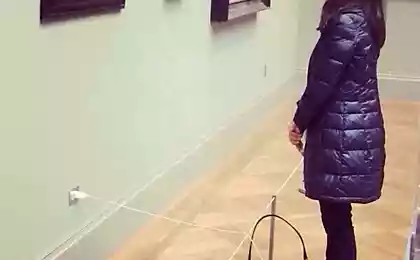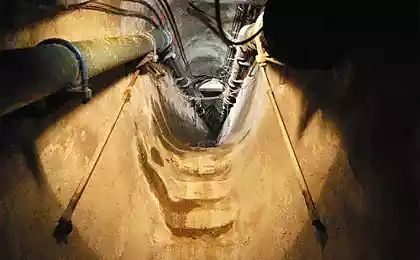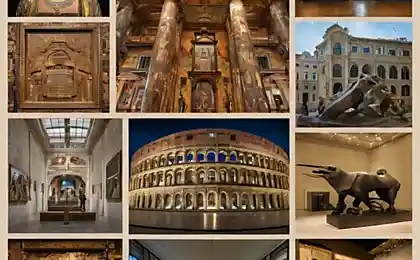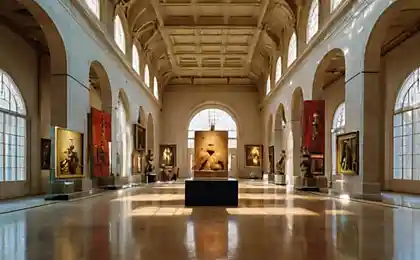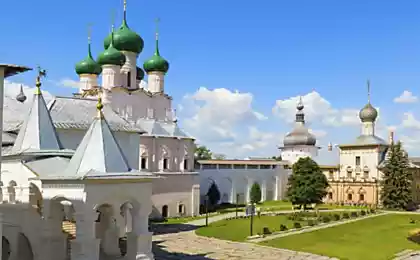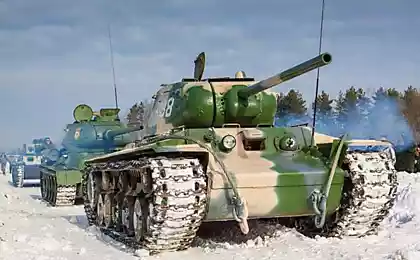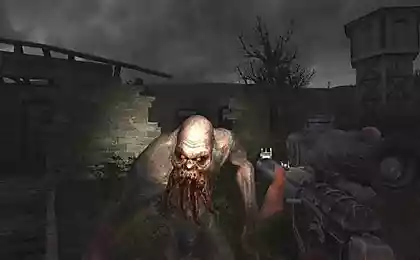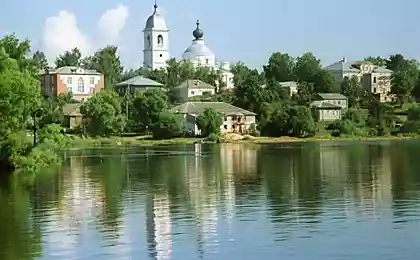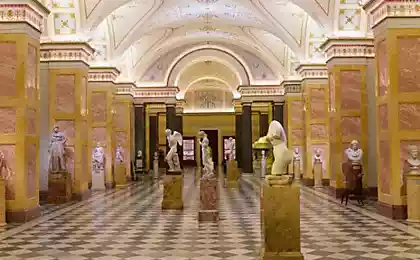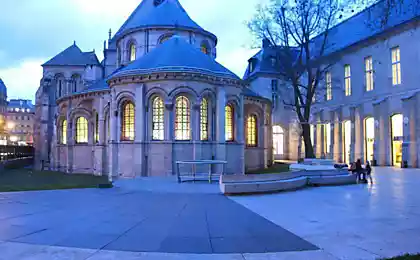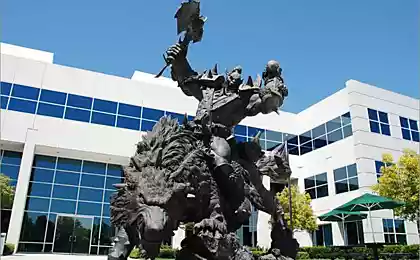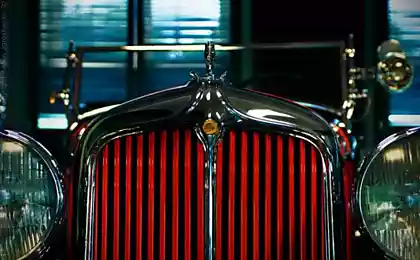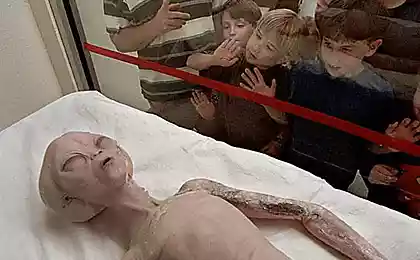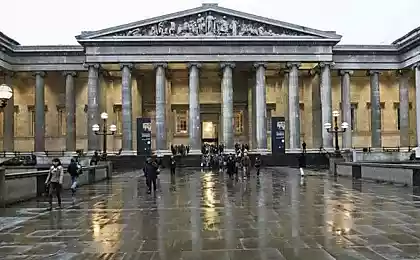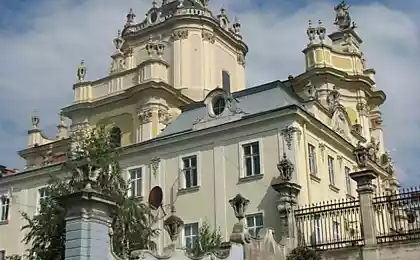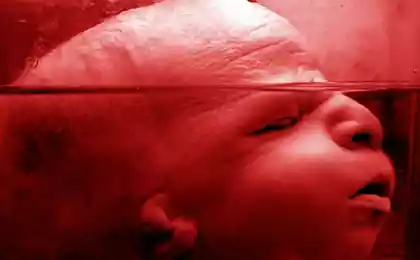1007
Museum military uniform
Museum military uniform was created based on the collection of the Imperial Quartermaster Museum, which existed before the revolution, under the patronage of the Russian Emperor. Supreme Decree was commanded to collect samples of both standard uniforms and experienced pilot, in order to "preserve the history of the samples of military uniforms».
40 photos via Vitaly Ragulin
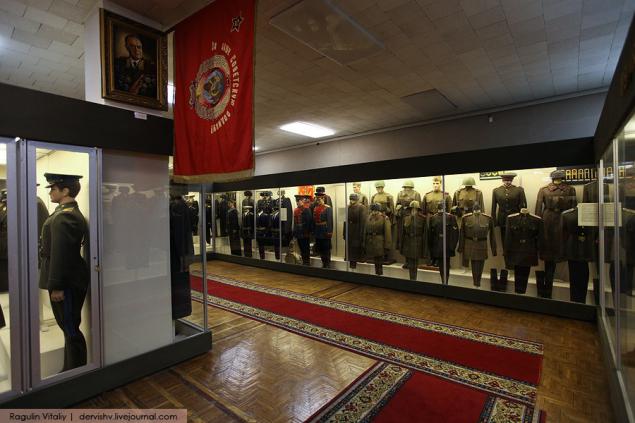
2. During the Revolution Museum quartermaster was partially looted and partially destroyed. The remains of the collection were transferred to the Quartermaster Museum: partly in the Museum of Artillery, Engineers and Signal Corps; partly in theaters and film studios; partly Quartermaster Directorate of the Red Army, for use as a sample uniform.

3. Regular part, and with them the uniform dress code appeared under Peter I. The soldiers wore a caftan: infantry - the green and in the cavalry - blue, one for all red cloth coat, hat, cocked hat and sword belt with a sword. Officers also believe scarf and a distinguishing mark on his chest. Peter I attached great importance to the appearance of their soldiers, took care to make them look dignified and at the same time were convenient for combat equipment.
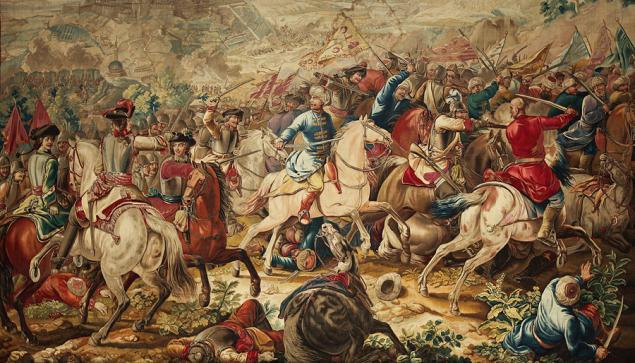
4. Presentation of the museum exhibits tell about how there was also changed in the Russian military uniform, who proudly wore many generations of defenders of the Fatherland.

5. For a long time there was a collection at the research laboratory of military uniform quartermaster service of the Defense Ministry and was shown only to specialists. Now the museum is open to anyone interested in military uniforms.

6. The vast majority of exhibits - historical originals.
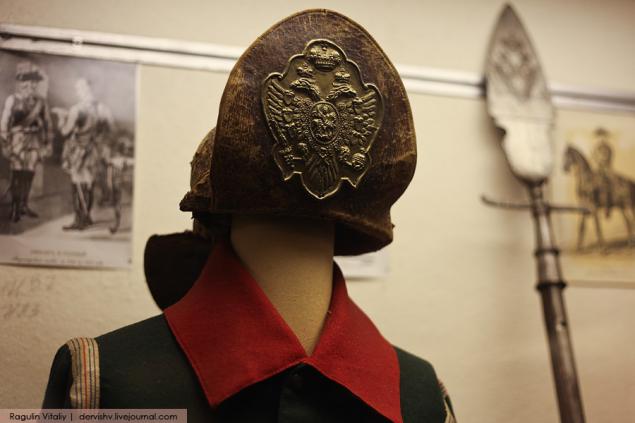
7.
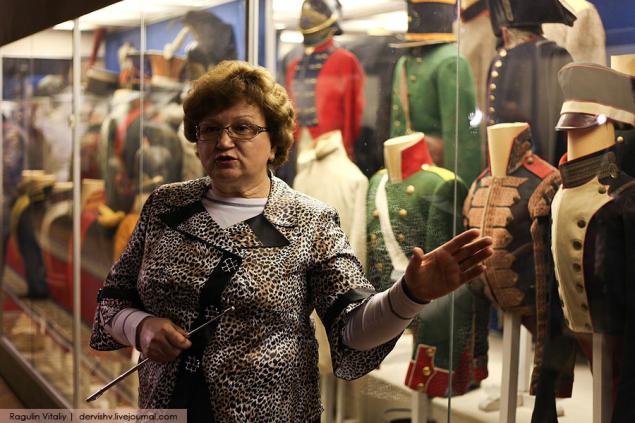
8. At the uniform visible eyelets for orders and medals.

9. outfit our army changed quite often, largely because of the enthusiasm by European statesmen dresses
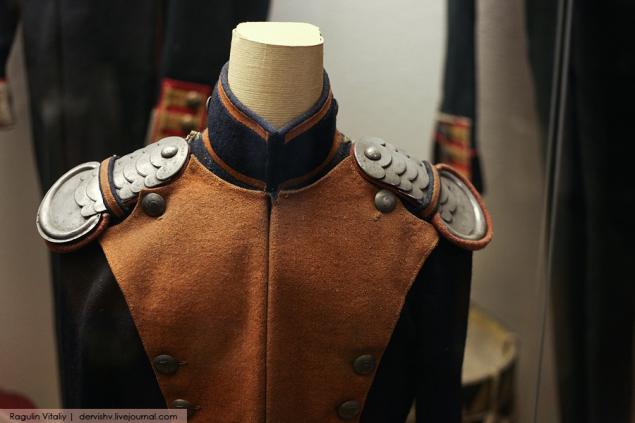
10. In the early Soviet era, exposure and not be faint. Some of the exhibits were presented to other museums, others are transferred to the theaters and movie studios. Much corny sold. And what's left, piled into boxes and locked up in a warehouse. To revive the museum could only after the war, when the survivors returned rarities Main Quartermaster Directorate. But only in 1985, exhibits housed in a modern heated building, equipped entirely by the rear services.
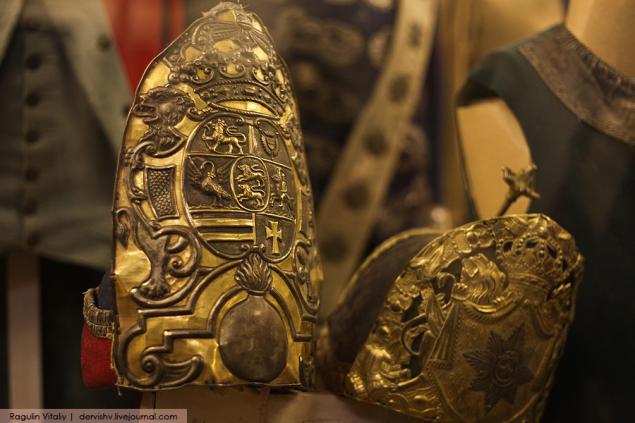
11. In local halls learn a lot about everyday things and names familiar since childhood. For example, foragers have long been the only Russian military servicemen, a headdress which casts visor. But not from affectation and not as a mark of distinction, and in purely practical reasons: it was thought that such a cap is very convenient to measure the horses oats.
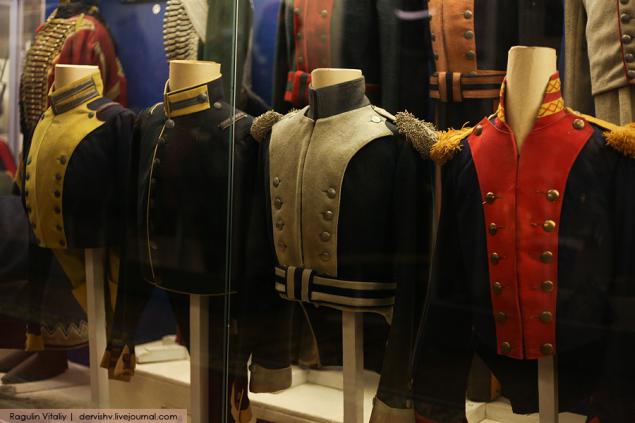
12. Tunic for a soldier has always been something more than just clothes. Not for nothing because upon separation from military service SPECIFICALLY right to wear military uniforms former soldiers. It was attached importance as one of the types of promotion and recognition.
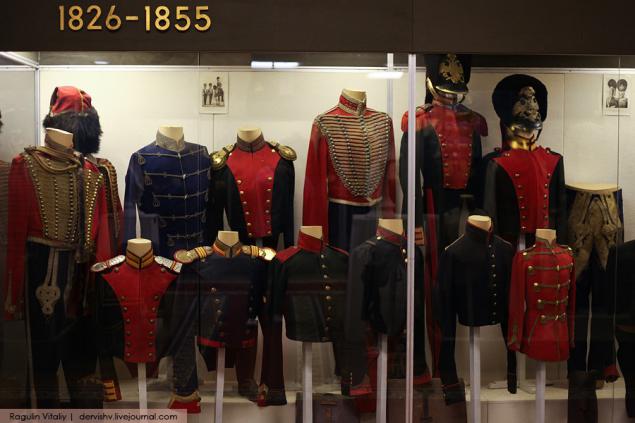
13.
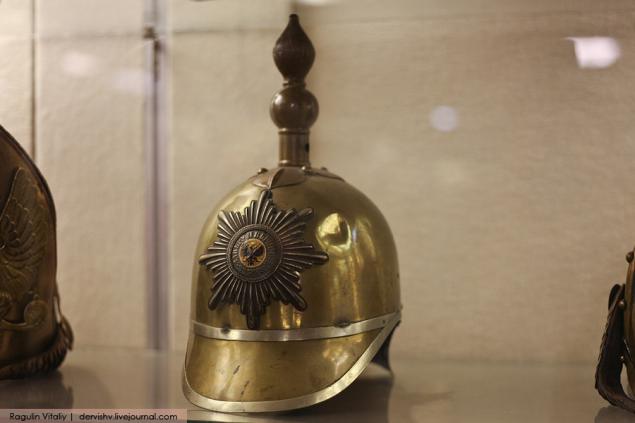
14.
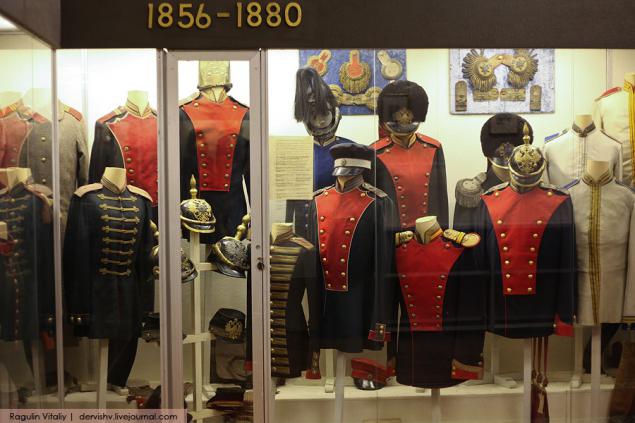
15
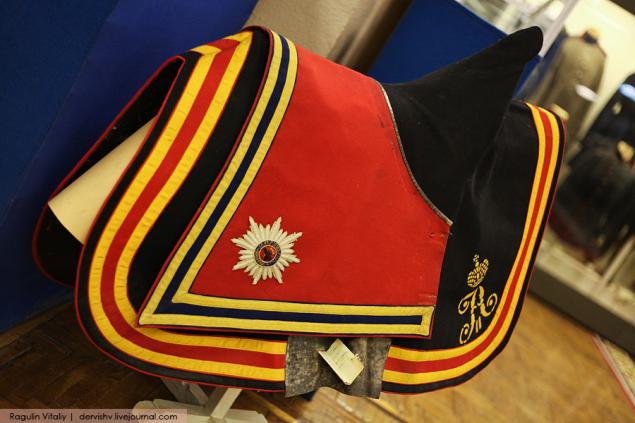
16
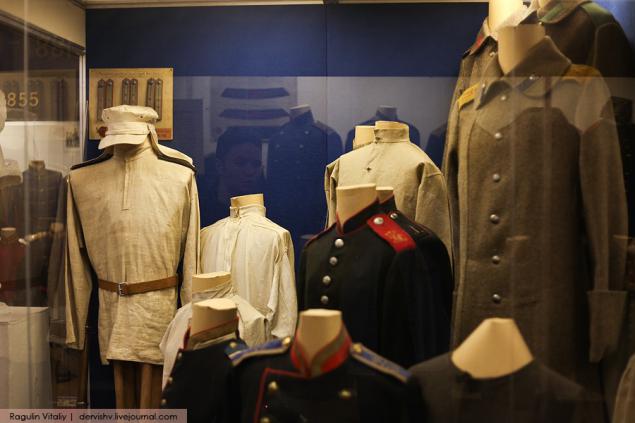
17
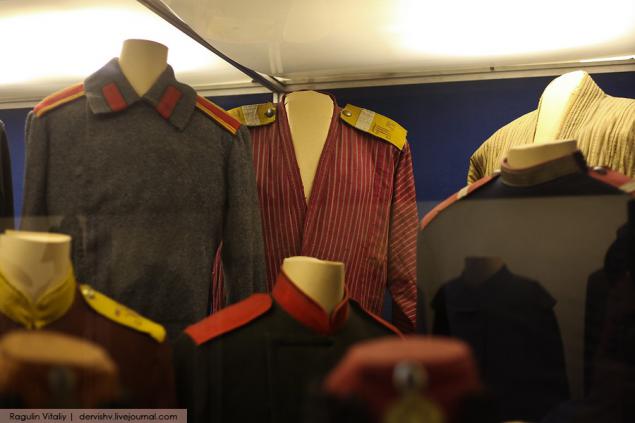
18

19
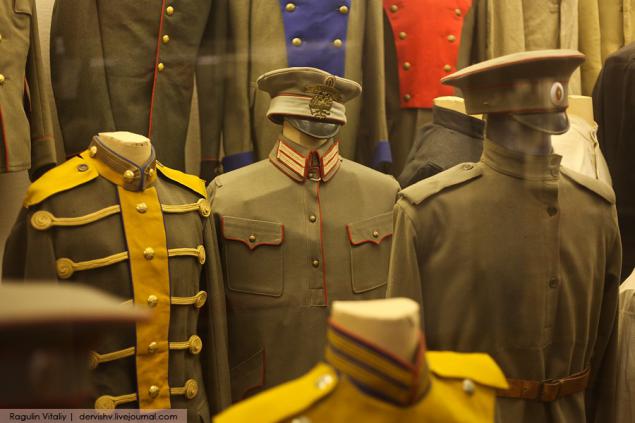
20. The history of the emergence of the shoulder straps and epaulettes. Initially epaulets - thick metal plates - were protected by saber strike, and shoulder straps are comfortable that protected the upper part of the uniform of the rapid deterioration in the situation of weapons "on his shoulder." In addition, they have cemented themselves as the rest of the outfit - sword belt, sling, backpack straps. Insignia they appeared later.
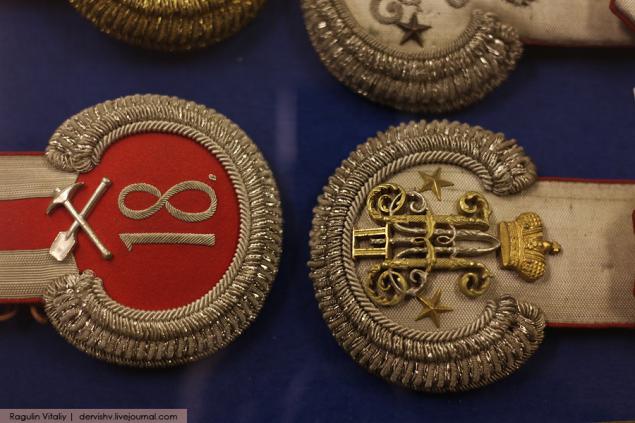
21. Voroshilov stuffed horse named Mauser.

22.

23. The museum has a large exhibition of military uniforms and post-revolutionary period.
Each cavalry regiment had its own color caps, and these regiments were already 128.
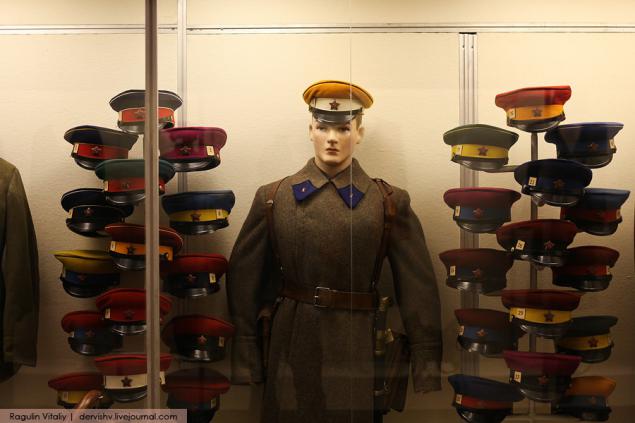
24.
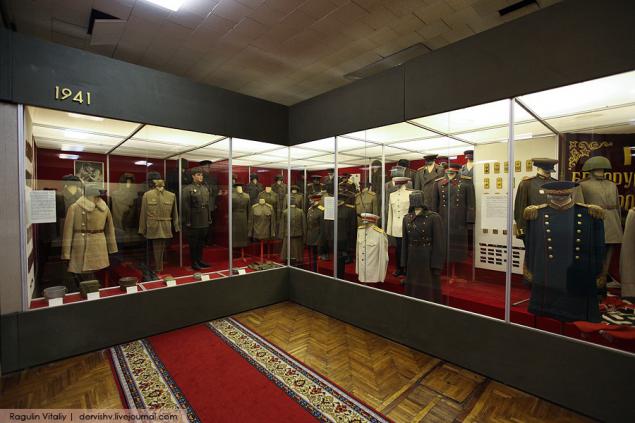
25. Standard of for the Victory Day parade. First option.
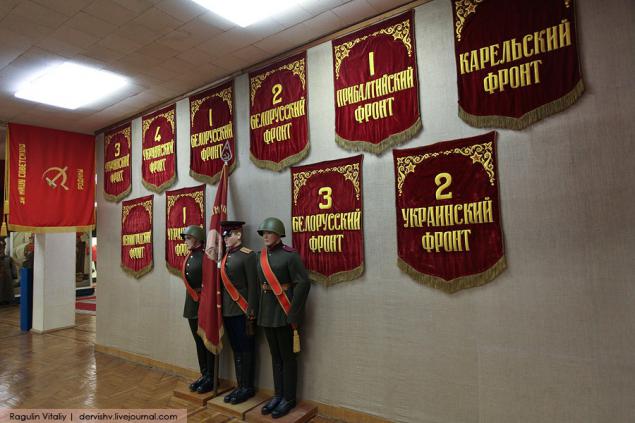
26.
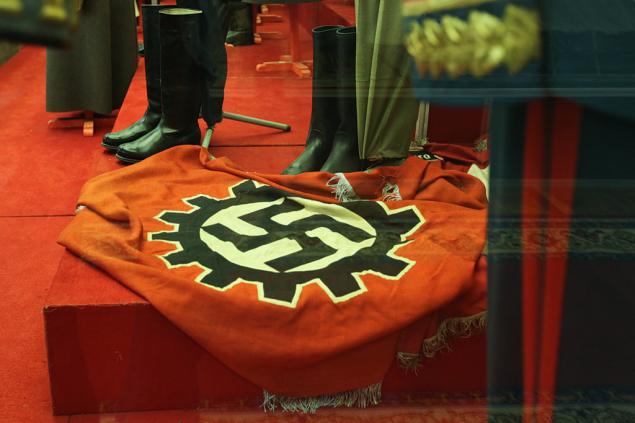
27. When the June 27, 1945 the Presidium of the USSR Bc awarded the title of Generalissimo Stalin, the question arose: what form now to face the commander in chief? The development of uniform for the owner of a unique rank assigned to the Chief of Logistics of the Armed Forces General Khruleva. Represented sewn shape Intendant Drachov Soviet army. Seeing the "outfit" Stalin frowned. I did not like him numerous braids, luxurious gold epaulettes and gold stripes on the trousers. Putting Dracheva, the chief said subordinates that does not want to look like a rooster or the doorman of the restaurant. It does not need to be told twice within a few days presented a uniform modest - woolen jacket with a turn-down collar. He received the highest approval. Now, both options can be seen form the generalissimo in a single place - the Museum of Russian, Soviet and foreign uniforms Central Clothing management of the Defense Ministry.
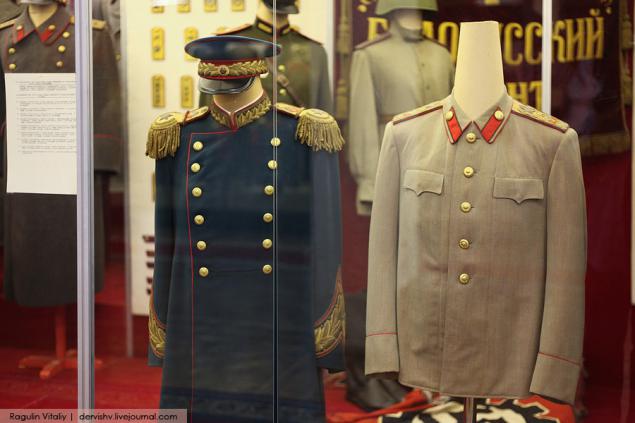
28

29
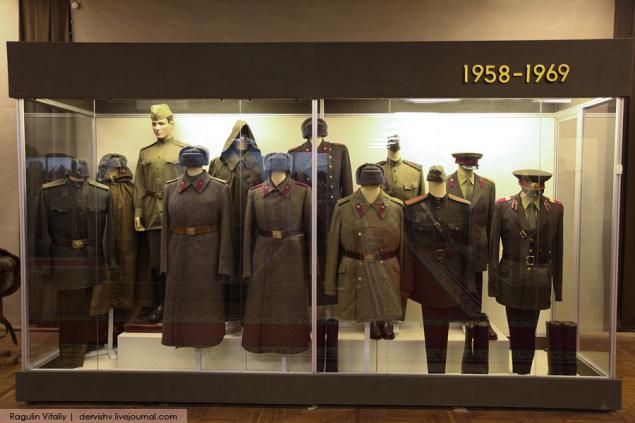
30
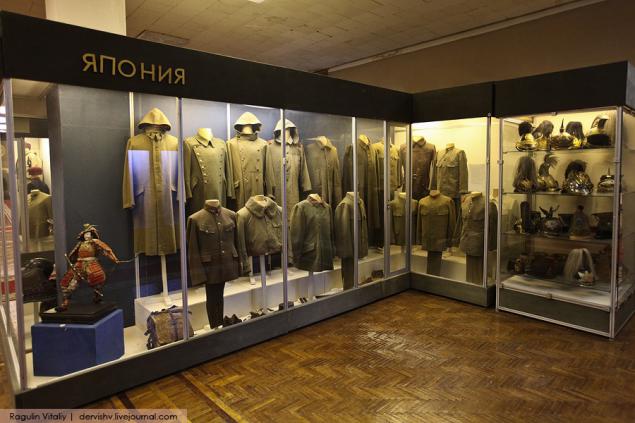
31
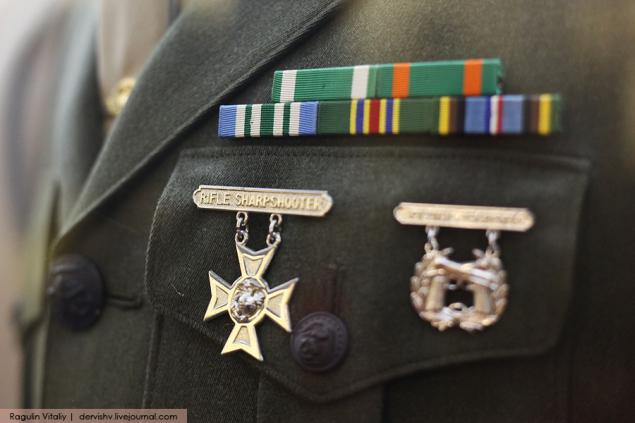
32
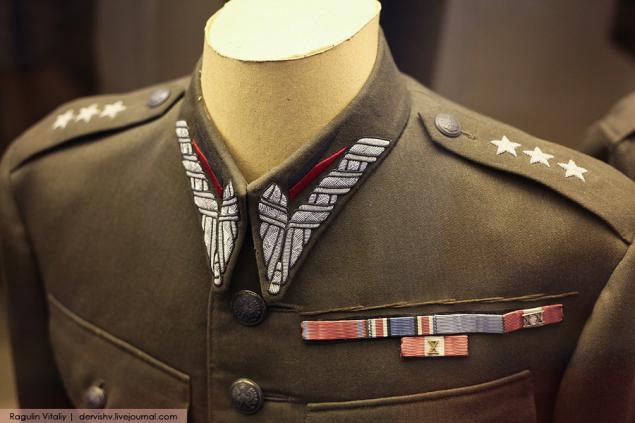
33
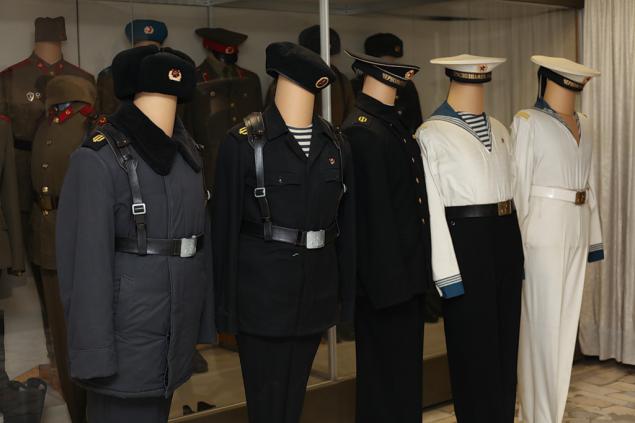
34

35. The museum has a large collection of awards from different countries.
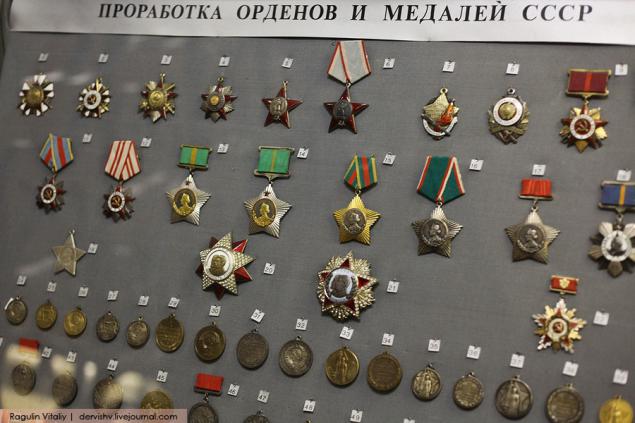
36
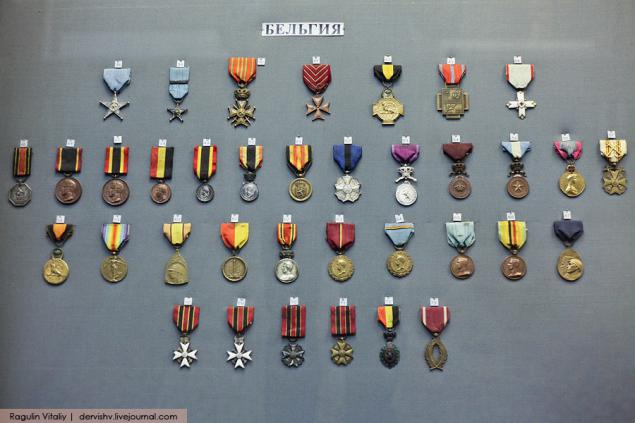
37
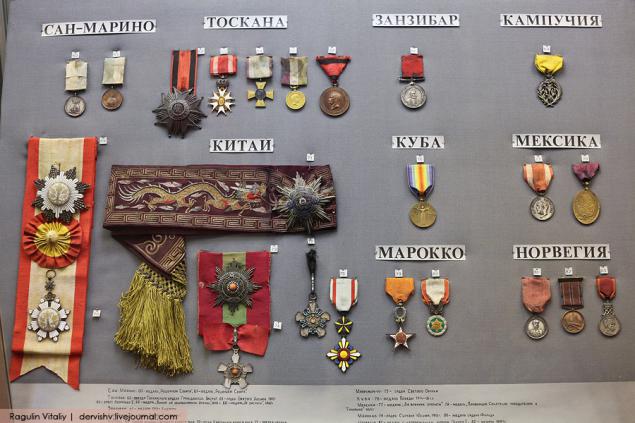
38
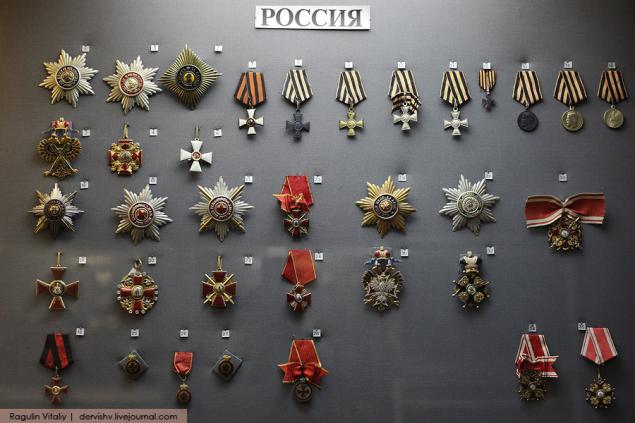
39

The museum is located on the territory of the military unit and a "sensitive" object, and therefore the need to apply in advance to visit.
In connection with the "fading" artifacts from camera flashes, the museum operates a certain light conditions and photography by special order.
Museum Address:
Mosca area n. Bahchivandzhi (Schelkovo-4),
w / h 762 TSOKB clothing service.
Phone: (495) 544-86-11.
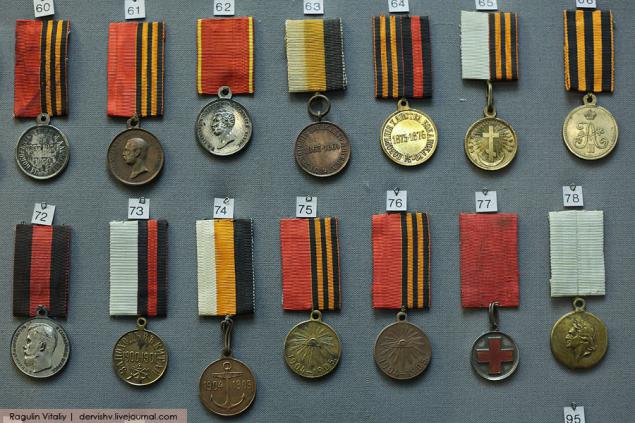
Source:
40 photos via Vitaly Ragulin

2. During the Revolution Museum quartermaster was partially looted and partially destroyed. The remains of the collection were transferred to the Quartermaster Museum: partly in the Museum of Artillery, Engineers and Signal Corps; partly in theaters and film studios; partly Quartermaster Directorate of the Red Army, for use as a sample uniform.

3. Regular part, and with them the uniform dress code appeared under Peter I. The soldiers wore a caftan: infantry - the green and in the cavalry - blue, one for all red cloth coat, hat, cocked hat and sword belt with a sword. Officers also believe scarf and a distinguishing mark on his chest. Peter I attached great importance to the appearance of their soldiers, took care to make them look dignified and at the same time were convenient for combat equipment.

4. Presentation of the museum exhibits tell about how there was also changed in the Russian military uniform, who proudly wore many generations of defenders of the Fatherland.

5. For a long time there was a collection at the research laboratory of military uniform quartermaster service of the Defense Ministry and was shown only to specialists. Now the museum is open to anyone interested in military uniforms.

6. The vast majority of exhibits - historical originals.

7.

8. At the uniform visible eyelets for orders and medals.

9. outfit our army changed quite often, largely because of the enthusiasm by European statesmen dresses

10. In the early Soviet era, exposure and not be faint. Some of the exhibits were presented to other museums, others are transferred to the theaters and movie studios. Much corny sold. And what's left, piled into boxes and locked up in a warehouse. To revive the museum could only after the war, when the survivors returned rarities Main Quartermaster Directorate. But only in 1985, exhibits housed in a modern heated building, equipped entirely by the rear services.

11. In local halls learn a lot about everyday things and names familiar since childhood. For example, foragers have long been the only Russian military servicemen, a headdress which casts visor. But not from affectation and not as a mark of distinction, and in purely practical reasons: it was thought that such a cap is very convenient to measure the horses oats.

12. Tunic for a soldier has always been something more than just clothes. Not for nothing because upon separation from military service SPECIFICALLY right to wear military uniforms former soldiers. It was attached importance as one of the types of promotion and recognition.

13.

14.

15

16

17

18

19

20. The history of the emergence of the shoulder straps and epaulettes. Initially epaulets - thick metal plates - were protected by saber strike, and shoulder straps are comfortable that protected the upper part of the uniform of the rapid deterioration in the situation of weapons "on his shoulder." In addition, they have cemented themselves as the rest of the outfit - sword belt, sling, backpack straps. Insignia they appeared later.

21. Voroshilov stuffed horse named Mauser.

22.

23. The museum has a large exhibition of military uniforms and post-revolutionary period.
Each cavalry regiment had its own color caps, and these regiments were already 128.

24.

25. Standard of for the Victory Day parade. First option.

26.

27. When the June 27, 1945 the Presidium of the USSR Bc awarded the title of Generalissimo Stalin, the question arose: what form now to face the commander in chief? The development of uniform for the owner of a unique rank assigned to the Chief of Logistics of the Armed Forces General Khruleva. Represented sewn shape Intendant Drachov Soviet army. Seeing the "outfit" Stalin frowned. I did not like him numerous braids, luxurious gold epaulettes and gold stripes on the trousers. Putting Dracheva, the chief said subordinates that does not want to look like a rooster or the doorman of the restaurant. It does not need to be told twice within a few days presented a uniform modest - woolen jacket with a turn-down collar. He received the highest approval. Now, both options can be seen form the generalissimo in a single place - the Museum of Russian, Soviet and foreign uniforms Central Clothing management of the Defense Ministry.

28

29

30

31

32

33

34

35. The museum has a large collection of awards from different countries.

36

37

38

39

The museum is located on the territory of the military unit and a "sensitive" object, and therefore the need to apply in advance to visit.
In connection with the "fading" artifacts from camera flashes, the museum operates a certain light conditions and photography by special order.
Museum Address:
Mosca area n. Bahchivandzhi (Schelkovo-4),
w / h 762 TSOKB clothing service.
Phone: (495) 544-86-11.

Source:

